From the previous posting, we asked the question:
Are there other mentions of Tablets discussing the land of Mu prior to the 1926 Lost Continent of Mu Motherland of Men?
James’ scrapbooks contain a good amount of data, mostly newspaper and magazine clippings, that subsequently saw light in his books. On the other hand, some information did not fit and was not included.
One such case in point are the 125 tablets that he and Buddhist scholars translated back in 1924 that was not mentioned in any of James other written works. Shown below are three newspaper clippings, one from November 1924 and two from January 1925 that describe his association with Buddhist scholars in translating 125 tablets that dated back 20,000 years and described the lost continent of Mu in the same terms that are used throughout James’ subsequent books.
These articles are followed by excerpts from an article written in August 1925 in the Oakland Tribune where there is no mention of the Buddhist scholars.
A serious researcher must seek the answers to the following questions:
- The similarities between the description of these tablets and the Naacal Tablets are very close, why didn’t they use the name “Naacal” when referring to them in the newspaper articles?
- If these were the Naacal Tablets, why didn’t James mention in his books his association with the Buddhist scholars translating them to add to his credibility?
- If these are not the Naacal Tablets, then would they not be another reference for the existence of Mu, why didn’t James use them (in addition to the Naacal tablets) in his written works?
- Are the stories about the 125 tablets and Buddhist scholars examples of a hoax?
- Could the Naacal Tablets also be fictional?
The data and questions are presented as is. The questions are for the reader to answer after careful consideration or a snap judgment, your call.
Have a great day.
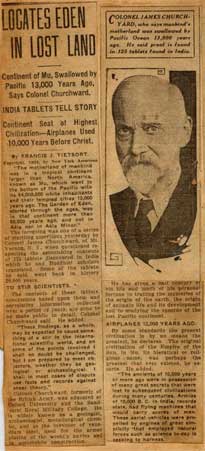
New York American
Monday November 10, 1924
Locates Eden in Lost Land
Continent of Mu, Swallowed by Pacific 13,000 Years Ago, says Colonel Churchward
India Tablets Tell Story
Continent Seat of Highest Civilization – Airplanes used 10,000 Years before Christ
Colonel James Churchyard, who says that mankind’s motherland was swallowed by Pacific Ocean 13,000 years ago. He said proof is found in 125 tablets in India.
By Francis Tietsort
“The motherland of mankind was in a tropical continent larger than North America, known as Mu, which went into the Pacific with its 64,000,000 white inhabitants and their templed cities 13,000 years ago/ The Garden of Eden, storied through the ages, was in that continent more than 50,000 years ago, and not in Asia nor Asia Minor.”
The foregoing was one of a series of startling assertions yesterday by Colonel James Churchward, of Mt. Vernon, N.Y. when questioned respecting the astonishing contents of 125 tablets discovered in India which he and Buddhist scholars translated. Some of the tablets, he said, went back in history 20,000 years.
The contents of these tablets, conclusions based upon them and correlative information collected over a period of years, are soon to be made public in detail, Colonel Churchward said. He added:
“These findings, as a whole, may be expected to cause something of a stir in the international scientific world, and on some of the points involved I shall no doubt be challenged, but I am prepared to meet my objectors, whether they be geological or archaeological. I shall in most cases of dispute use facts and records against their sheer theory.”
Colonel Churchward, formerly of the British Army, was educated at Oxford University and the Sandhurst Royal Military College. He is widely known as a geologist, archaeologist, metallurgical chemist and as the inventor of vanadium steel, used for the armor plating of the world’s navies and in automobile construction.
He has given half a century of his life and much of his personal fortune to trailing the mysteries of the origin of the earth, the origin of animate life, and its development and to studying the records of the lost Pacific continent.
…
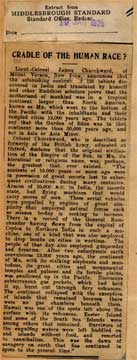
Middlesborough Standard
Standard Office, Redcar
10 Jan 1925
Cradle of the Human Race?
Lieut-Colonel James Churchward, of Mount Vernon, New York, announces that the astonishing contents of 125 tablets discovered in India and translated by himself and other Buddhist scholars prove that the motherland of mankind was in a tropical continent larger than North America, known as Mu, which went to the bottom of the Pacific with the inhabitants and their templed cities 13,000 years ago. The tablets say that the Garden of Eden was in that continent more than 50,000 years ago, and not in Asia or Asia Minor.
Colonel Churchward, who is described as formerly of the British Army, educated at Oxford, declares that the original civilization of the Empire of the Sun, in Mu, its hieratical or religious name, was, perhaps, the greatest that ever existed. “The ancients of 10,000 years or more ago were in possession of great secrets lost to subsequent civilizations during many centuries. Armies of 10,000 B.C. in India, the records state, had flying machines that would carry scores of men. These aerial vehicles were propelled by engines of great simplicity that employed natural forces such as science to-day is seeking to harness. There is a record of the General Ramchander having flown from the capital of Ceylon to Northern India in such a machine, one of a kind that was also employed to drop bombs on cities in wartime. The people of that day also employed gunpowder and firearms. After two cataclysmic earth convulsions 13,000 years ago, the continent of Mu, with its stalking elephants and mastodons, its great cities and monumental temples and palaces and its fertile plains, was swallowed up in the Pacific. Enormous subterranean gas pockets, which had held it up, burst out through fiery volcanoes. The continent collapsed with the exception of islands that remained because there were no gas chambers beneath them. Hawaii was one of the spots left above the surface with its volcanoes. Easter Island and some of the South Sea Islands were among others that remained. Survivors of the engulfing waters were left huddled on and islands without food, and, resorted to cannibalism. This was the dawn of savagery on earth that has continued in spots to the present time.”
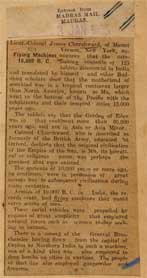
Extract from
Madras Mail, Madras
Jan 3, 1925
Flying Machines 10,000 B.C.
Lieut-Colonel James Churchward, of Mount Vernon, New York, announces that the astonishing contents of 125 tablets discovered in India and translated by himself and other Buddhist scholars prove that the motherland of mankind was in a tropical continent larger than North America, known as Mu, which went to the bottom of the Pacific with the inhabitants and their templed cities 13,000 years ago.
The tablets say that the Garden of Eden was in that continent more than 50,000 years ago, and not in Asia or Asia Minor.
Colonel Churchward, who is described as formerly of the British Army, educated at Oxford, declares that the original civilization of the Empire of the Sun, in Mu, its hieratical or religious name, was, perhaps, the greatest that ever existed.
The ancients of 10,000 years or more ago were in possession of great secrets lost to subsequent civilizations during many centuries.
Armies of 10,000 B.C. in India, the records state, had flying machines that would carry scores of men.
These aerial vehicles were propelled by engines of great simplicity that employed natural forces such as science to-day is seeking to harness.
There is a record of the General Ramchander having flown from the capital of Ceylon to Northern India in such a machine, one of a kind that was also employed to drop bombs on cities in wartime. The people of that day also employed gunpowder and firearms.
***
An later newspaper article appearing in the Oakland Tribune on August 16, 1925 with the title, Sacred Indian Tablets Disclose New Story of World’s Creation was written by James Churchward. The article discusses his interaction with the Rishi, just as in the 1926 Lost Continent of Mu Motherland of Men and not mentioning any Buddhist scholars.

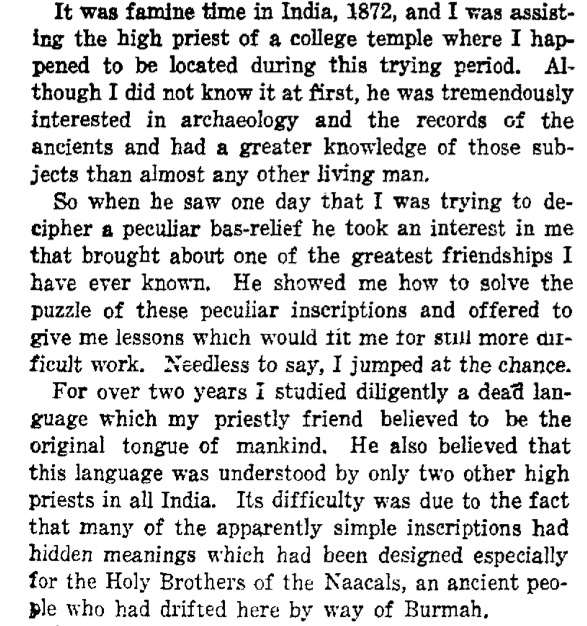




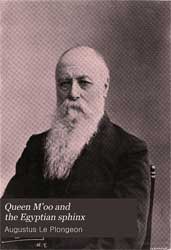
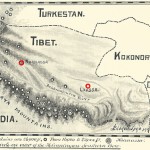
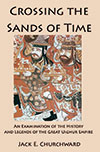
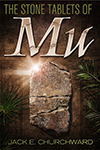
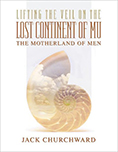



 RSS - Posts
RSS - Posts